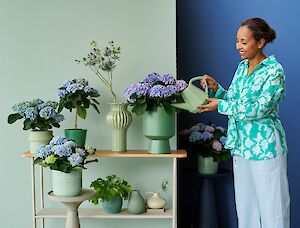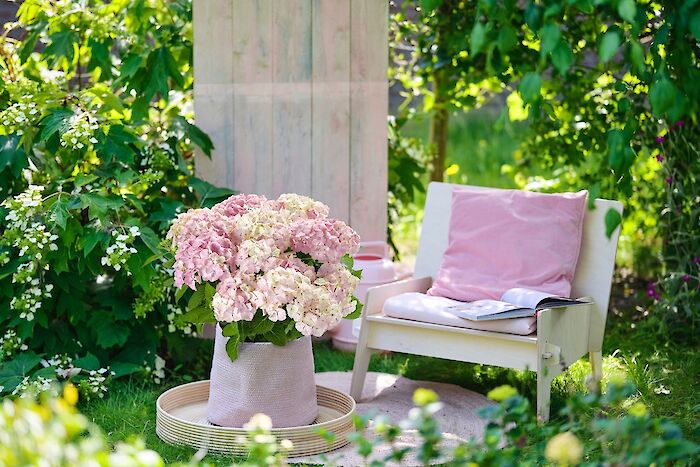Tips
Indoor hydrangea: magical colours and healthier air in your home
Summer is in full swing: the sun is shining, temperatures are rising and your indoor hydrangea is in the midst of its flowering. With full flowers that dance along with the colours of the season, this plant brings a cheerful, magical atmosphere to the home.
Indoor hydrangeas are not just a feast for the eye, but also help to create a healthier indoor environment. The plant uses photosynthesis to convert carbon dioxide into oxygen, which improves air quality. It also boost humidity by releasing water vapour. This natural action creates a fresher, more pleasant environment. Just what you need during the hot summer months.
With proper care, your indoor hydrangea will stay not only beautiful, but also vigorous. You can find practical tips and information below on how to help this plant do its best work.
The perfect spot: lots of light without bright sunshine
Indoor hydrangeas like plenty of light, but bright midday sun can damage the leaves. An east- or west-facing window is therefore ideal: the plant gets enough daylight without the risk of getting burned.
Pay close attention to the leaves. If they are pale or yellow, the plant is probably getting too much light. If the location is too dark, flowering will be reduced. So strike the right balance and move the plant if necessary.
Watering: enough, but carefully
Water evaporates faster in summer, so check the top layer of the soil regularly. If it feel dry to the touch, water generously until it runs out of the pot. Make sure excess water can always drain well to prevent the roots from rotting.
Immersing the plant is also a great way of watering: place the pot in a bowl of water briefly and to let the roots drink their fill. Then allow the plant to drain well before returning it to its pot.
Balancing temperature and humidity
Indoor hydrangeas are most comfortable at temperatures between 15 and 22 degrees. Avoid draughts and locations where air conditioning blows directly onto the plant.
Since the hydrangea also emits water vapour, the plant helps maintain humidity levels. In rooms that are dry, e.g. due to air conditioning, extra misting on the leaves can offer additional comfort. Never spray directly onto the flower globes to prevent fungal infections.
 Indoor hydrangeas have a positive impact on a healthy indoor climate. Thanks to its strong moisture-regulating properties, the plant helps ensure good humidity in the home. This can reduce complaints such as dry skin, headaches and dry eyes, making you feel more comfortable with this houseplant in your home.
Indoor hydrangeas have a positive impact on a healthy indoor climate. Thanks to its strong moisture-regulating properties, the plant helps ensure good humidity in the home. This can reduce complaints such as dry skin, headaches and dry eyes, making you feel more comfortable with this houseplant in your home.
Feed for strong flowering
Feed the plant once every fortnight with plant feed specifically made for flowering houseplants. This helps the indoor hydrangea stay vigorous and stimulates the production of new flowers.
Always use the dosage recommended on the packaging to avoid damaging the roots.
Want to find out more about feeding? Then check out our care page ''Additional feeding and care for indoor hydrangeas''
Remove wilted flowers
Carefully cut away wilted flowers just above the first healthy leaf. This will allow the plant to invest its energy in new growth and flowering.
Pay close attention to the plant
Firm, fresh green leaves are a sign of a healthy plant. Spots, drooping leaves or small insects can indicate problems. Remove affected parts and ensure plenty of fresh air.
Regular monitoring prevents minor issues from growing into bigger problems.
With love and attention, your indoor hydrangea will remain a magical centrepiece in your home this summer. Not just because of its beauty, but also thanks to the fresh, healthier air that this special plant contributes to the room.
Want to find out more about caring for your hydrangea?
Read all the practical tips for a healthy and blooming hydrangea on our care page.



